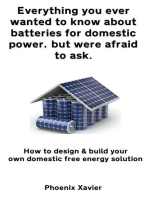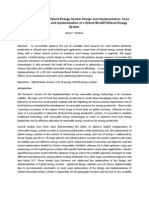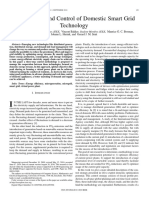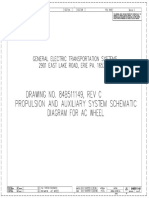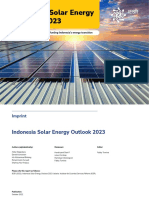Professional Documents
Culture Documents
Open Letter To C40: Finance and Economics of Energy Retrofits
Uploaded by
Rogier Fentener van VlissingenOriginal Title
Copyright
Available Formats
Share this document
Did you find this document useful?
Is this content inappropriate?
Report this DocumentCopyright:
Available Formats
Open Letter To C40: Finance and Economics of Energy Retrofits
Uploaded by
Rogier Fentener van VlissingenCopyright:
Available Formats
February 27, 2014
Open Letter to C40: Finance and economics of energy retrofits Reducing Green House Gas emissions is now the primary focus regarding climate change !uildings"thus the urban en#ironment in particular"are responsible for 40$ of emissions %&'(), and therefore represent a huge opportunity for impro#ement The only strategy that will work is prioritizing retrofits that maximize Site Derived Renewable Energy (SDRE), and an prod! e over "#$ red! tions in %&% emissions' Energy Effi ien y (EE) is not an energy so!r e and at best a se ondary ob(e tive be a!se it applies e)!ally to *ossil *!el+based (**) systems as to SDRE' *ote+ ,his paper is *ew -or. and &'/centric, but most points can be generali0ed where appropriate
/2/
Reducing GHG-emissions with Renewable Energy
1n the &'(, buildings produce about 40$ of GHG/emissions, and offer ma2or opportunity for Renewable 3nergy %R3) ,his is well understood in new construction, as can be seen from the consistent growth of net/0ero, near/0ero, or net/positi#e construction 1t is not yet well understood in retrofits, yet many, buildings are suitable, and the potential is still being generally o#erloo.ed For *ew -or. 4ity, 5la*-4 put energy and climate change on the agenda 1n a report we issued in 2011 the 67a!8 5la*-420209, we suggested strategies for '7R3 retrofits of *ew -or. 4ity:s thousands of old/line apartment buildings, and demonstrated ways of achie#ing 70 to ;0$ GHG/reduction 1n 201< the &rban Green 4ouncil issued their 6;0 by =09 report, targeting ;0$ GHG/ reduction by 20=0, which generali0ed the approach to all ma2or building types in *ew -or. 4ity ,hese radical retrofit approaches focus on le#eraging multiple ways to generate energy on/site, which means acti#e and passi#e renewable technologies, combined with thermal impro#ements, insulation, etc , and through integration of multiple technologies a con#ersion plan can be de#eloped, phasing/in the retrofit process gradually in line with the replacement cycles for e8isting infrastructure Government should incentivize GHG-reductions, and property owners should maximize property values, or extends the useful economic life of buildings. (ll incenti#es at the technology le#el should ideally be phased out, as they merely muddy the decision, and lead to bad design 1n the &'(, the !aucus energy ta8 proposal introduces this logic, although it is fatally flawed %for now>) because it limits itself to the supply side of the grid/?electricity generation and production of transportation fuels @e can only hope it will be e8panded to include the demand side, because with '7R3 more energy generation will be mo#ing to the demand side, so the meaning of the grid is changing 1n short, a property owner needs a long/term plan that ta.es into account the replacement times for boilers, windows, roofs etc and to gradually con#ert the building from consuming energy, to generating its own @ithout a plan, the property owner would ris. ma.ing decisions that he will regret later ,he payoff comes when integration creates legitimate engineering synergies, e g a geothermal hot water or HA(4 system doubles as energy storage for your wind turbine or solar 5A, so two pieces of eBuipment that might ha#e a se#en and a si8
/</
year paybac. indi#idually, together might ha#e a fi#e year paybac. ,he basic modeling strategy can use such tools as the 35(:s 3nergy 'tar 5ortfolio manager, which shows the integrated effect, complete with GHG/reduction, and energy sa#ings @ith the resulting cash flow model, those synergies can be readily seen !y focusing on a <0 year capital budget, it becomes e#ident that '7R3 solutions win because <0 years of free energy beats 1=/2=$ of energy sa#ings, as long as adeBuate financing is a#ailable 1f the retrofit is designed right, financing options such as 5(43 bonds will facilitate paying for retrofits from energy sa#ings '7R3 is capital intensi#e, but it mo#es energy from liabilities to assets, and increases building #alues 1n the long term, building preser#ation will go hand in hand with successful '7R3 retrofits 4on#ersely, buildings that remain on fossil/fuel will continue to lose #alue with e#ery energy price hi.e or en#ironmental penalty ,hey are the slums of the future and ultimately destined for demolition
Why Energy Efficiency is not an objective by itself
,he biggest fallacy of the green mo#ement has been the practice of treating 3nergy 3fficiency as a goal in itself, and as an alternati#e to Renewable 3nergy 3nergy 3fficiency is not an energy source 3nergy 3fficiency is about the efficiency of Fossil Fuel based systems, which is what we are wanting to mo#e away from 1t should be wor.ed out between the energy companies and their customers, not with public money Energy Efficiency is equally relevant in both cases either in a fossil fuel-based building infrastructure, or in a building with !"#E, but the specific EE technology choices will be different in the fossilfuel or the #E cases, so the two strategies are generally neither interchangeable, nor always complimentary, but mutually exclusive. 1n short, the alternati#es are fossil/fuel %subscription energy) #ersus R3, which means it is a ma.e or buy decision, where renewable energy implies generating the energy, and buying the eBuipment to do so on/site %'ite 7eri#ed Renewable 3nergy"'7R3) 4urrent policy framewor.s suggest that the alternati#e choices are 33 #ersus R3, but in truth that obfuscates the fact that the choice is between Fossil Fuels %FF) #ersus Renewable 3nergy 3nergy 3fficiency is important in either case EE in a fossil-fuel infrastructure is not worthy of subsidy from a macro $policy level% because it competes with !"#E, and is an indirect subsidy of the fossil-
/4/
fuel industry, not to mention regressive with respect to GHG-reduction. 1n the short run, it would reduce GHG emissions, but it would e8tend our dependence on fossil/fuels, and thus maintain GHG/emissions in the long run &herefore, EE if applied to 'ossil 'uel-based systems will not ultimately reduce GHG emissions, as it results in a long-term extension paid for by a short term reduction. (t the micro level of each property, EE as a strategy is an investment trap for owners, because it features strongly diminishing returns. !avings is a limit function only so much can be saved. EE is not an in#estment, but operational sa#ings at best, and is a financial dead end because of the problem of diminishing returns, and therefore erodes building #alues in the long run ,he typically small 6sa#ings9 of 1=/2=$ can get erased by 2ust a few energy price hi.es, or become irrele#ant o#er time when compared to other properties with '7R3 and 70, C0, or ;0$ reduction in GHG/emissions, and a near complete elimination of energy bills *ewer construction that may be net/0ero or near/0ero, also wipes out the #alue of fossil/fuel dri#en buildings, regardless if they sa#ed 1= or 2=$ o#er last year
Why thermal technologies carry the day in retrofits
1f you need to transport energy long distance, electricity is superb, because you only ha#e about <$ transportation losses !y comparison, thermal energy can hardly be transported long distance Howe#er, within buildings the transportation issue is immaterial, as heat can be stored %e g hot water), which allows energy har#esting ,his is where thermal solutions shine because they are more efficient and they allow storage 3#ery con#ersion loses energy, for e8ample the con#ersion from solar rays to electricity is currently 17$ efficient, and then, if you use that electricity to heat water, you lose efficiency again %although a good heater could be ;0/;=$ efficient ) !ut 'olar ,hermal is ;C$ efficient today, and if you are generating on/ site, the ad#antage of electricity for transportation is irrele#ant ,herefore solar thermal water heaters carry the day, and allow you to store energy for later use ? energy har#esting brings higher returns than selling bac. to the grid 5eople thin. their HA(4 system is electric, and they buy 'olar 5A panels !ut the real demand is not electricity but !,&s for heating or cooling ,herefore it would be smarter to forget the 10$ cost sa#ings from solar 5A, and switch to
/=/
solar thermal HA(4 ne8t time the system wears out (lternati#ely, geothermal might be a good choice, because it yields four times the energy it consumes
Stop bashing the grid
,here are legitimate cases where the grid is dysfunctional"in local micro grids, and in flood 0ones, where resilience reBuires complete independence (s more and more '7R3 is installed, other areas should become more resilient also and retain some functionality in blac.outs or natural disasters ,he focus on 33 has been an inheritance from the oil crises in the 1;70:s when the conclusion was reached that the incremental dollar buys more demand reduction %by increased efficiency) than incremental supply %the *1D!- syndrome pertains to power plants ? nobody wants one in their bac. yard) ,oday, we ha#e a lot of options for '7R3 which did not pre#iously e8ist, and the payoff is in ma8imal use of '7R3 ,he grid retains its #alue as a bac.up, and as the way to distribute energy ,he grid is much maligned these days by all the solar homesteaders who want to use it as a storage facility, and preferably not pay for the pri#ilege, or e#en ma.e money off it ,he electrical grid is indispensable, and will remain so for a long time to come, but its function is changing and the sooner we catch up to that fact, the better off we will all be !esides the e#olution of the smart grid, regulators and consumers should get used to the fact that the economics are changing, and that regulators cannot ta.e re#enue away from the grid, and e8pect the grid to function in the long run 1ntelligent energy design howe#er should in#ol#e capacity planning with the grid operators and utilities 'ome buildings are going to become energy generators ,here will be opportunities to ma8imi0e utili0ation of the grid which is economically constructi#e
Bring bac the invisible hand
*ot to say the mar.et may not need a hand sometime, but you can:t push the ri#er, so massi#e central planning, 2ust li.e the infamous 'o#iet central planning system, will usually fail ,he economic interests of building owners should be engaged to ensure proper results
/E/
!y focusing on simply incenti#i0ing GHG/reductions %the desired effect), it is up to property owners to achie#e that in the best way possible (s stated abo#e, building owners should ma8imi0e the #alues of their buildings 1n *ew -or., 5la*-4 put energy and climate change on the agenda, but some of its components, such as *-4 4lean Heat and Focal Faws C4GC7GCC accomplished little or nothing, or e#en lead to outright capital destruction, and are regressi#e for GHG/reduction %see+ http+GGthin.progress orgGclimateG2014G02G1;G<2;EC<1Gnatural/gas/climate/ benefitGH) 1t is now widely understood that natural gas is worse than oil or coal from a GHG standpoint, and *ew -or. has become disastrously dependent on *atural Gas, thereby greatly decreasing resilience 1n the winter of 2014 citi0ens paid for this foolishness with outrageous electrical rates, on top of high heating bills %,enants don:t pay the heating bills, but they are paying for the foolishness anyway, because electrical rates are now dri#en by natural gas Ianuary traditionally has the lowest electrical rates of the year, this was still the case in 2012, when the 4on3dison rates in Ianuary were 7 centsG.@h, but in 201< it was 1< centsG.@h, and by 2014 it was up to 22 cents) 1n short, *-4 4lean Heat 7i#erted oil buildings to gas, for no en#ironmental gain, and great economic cost, both in terms of rates, and for the loss of resilience %by eliminating di#ersity of energy sources), and it collided with electricity generation, which also switched to gas at the same time (t the same time frac.ing is increasingly under pressure, e#en aside from the disastrous effect of methane losses during production and distribution !uildings should be encouraged to switch to '7R3, instead of substituting one fossil fuel for another Jwners might do that opportunistically, but that does not necessarily deser#e public financial support @hat would help is to sponsor con#ersion pro2ects to demonstrate the feasibility and the #alue of '7R3 con#ersions 3#entually, the mar.et will ta.e o#er, because the #alues of '7R3 buildings will be much more resilient, as sophisticated in#estors already .now ,here is a 2ob to be done with enabling regulation to ma.e '7R3 con#ersions possible %the familiar 6split incenti#e9 between landlords and tenants comes to mind) Regulations reBuiring the pro#ision of heat and hot water only should change, for with '7R3 there is #ast efficiency to be gained from central HA(4, and landlords should be able to charge for (G4 on a !,& basis, to support the con#ersions @indow air conditioners will be unwor.able if by 20=0 we ha#e <
/7/
times the number of ;0KF days each summer, as is now predicted, plus, central HA(4 facilitates tighter windows and heat e8change #entilation 1f buildings can generate enough electricity, owners could switch to electrical coo.ing and eliminate a #ery bad source of indoor air pollution 1n short, 6;0 by =09 is feasible, but only if we start planning for it today, and support it through policy immediately (nd approaches of switching o#er to R3 should minimi0e cost by ma8imi0ing the proper seBuencing and staging of retrofits to coincide with replacement cycles %boilers, roofs, windows, etc ) ,hus it is better not to waste resources on switching from oil to gas when the burnerGboiler still has economic life left in it !etter to do a con#ersion to solar thermal HA(4 when the end/of/life arri#es for the boiler 1n the interim, a geothermal hot water system and other impro#ements could be implemented
!inancial reality" EE securiti#ations are troubled
!oth the 4ommonwealth of 5ennsyl#ania and *ew -or.:s *-'3R7( ha#e e8perienced difficulty in placing portfolios of 33 loans in the secondary mar.et 33 lending is doomed because it undermines building economics ,he short term gain in disposable cash is nullified by the e#entual loss of #alue in the property '7R3 lending %with 5(43 bonds or otherwise) could be far more successful with the right underwriting policies 'erial in#estments based on asset bac.ed financing and marginal energy sa#ings face diminishing returns ,hey also cherry pic. the economics of more comprehensi#e '7R3 con#ersion pro2ects, or owners shoot themsel#es in the foot with 33 pro2ects that later on may pro#e to be suboptimal or outright wrong in an '7R3/retrofit ,he emphasis needs to be on <0 year capital budgets for energy for entire properties, which ma8imi0e building #alue andGor economic life, and minimi0e GHG/reductions
$onclusion" for GHG-reductions% focus on S&RE not EE
,he focus on 33 was happily coopted by the fossil/fuel industry, but, properly considered, it is a total green wash 'rom a policy standpoint, !ite "erived #enewable Energy is the only real way towards reducing GHG remissions. Energy Efficiency $of existing 'ossil 'uel systems% as a priority is a bad proxy for GHG-reductions, because it produces short term gain, but undermines GHG-reductions in the longer run.
/C/
,he most producti#e strategy therefore is to ma8 out on R3 opportunities now, and rapidly reduce total GHG/emissions from building stoc. 1ncenti#i0e actual GHG/reductions Fet fossil/fuel companies and their customers wor. out the most efficient systems possible, for the competiti#e pressures from R3 retrofits with high GHG/reductions as well as net 0ero and near 0ero new construction will put fossil/fuels on the defensi#e 'ubsidi0ing 3nergy 3fficiency in Fossil Fuel buildings creates a subsidy for the fossil/fuel industry, and achie#es the opposite of what is intended 44 by 4 0, 2014, Rogier Fentener #an Alissingen ( copy of this letter will be published on 'cribd
You might also like
- DIY Free Home Energy Solutions: How to Design and Build Your own Domestic Free Energy SolutionFrom EverandDIY Free Home Energy Solutions: How to Design and Build Your own Domestic Free Energy SolutionRating: 5 out of 5 stars5/5 (1)
- Everything you Ever Wanted to Know About Batteries for Domestic Power, but Were Afraid to askFrom EverandEverything you Ever Wanted to Know About Batteries for Domestic Power, but Were Afraid to askNo ratings yet
- Hydrogen As An Energy Vector To Optimize The Energy Exploitation - 2020 - EnergyDocument12 pagesHydrogen As An Energy Vector To Optimize The Energy Exploitation - 2020 - EnergyИлия ГеоргиевNo ratings yet
- Hybrid Energy Systems ThesisDocument8 pagesHybrid Energy Systems Thesislaurenbarkeringlewood100% (2)
- 1-s2.0-S2352152X19316251-mainDocument8 pages1-s2.0-S2352152X19316251-mainenerpowaprojectsNo ratings yet
- Research Papers On Hybrid Power GenerationDocument8 pagesResearch Papers On Hybrid Power Generationvguneqrhf100% (1)
- Class1 OptimizationHybridEnergySystemDocument5 pagesClass1 OptimizationHybridEnergySystemparchure123No ratings yet
- Technical and Economic Study For Electricity Production by Concentrated Solar Energy and Hydrogen StorageDocument11 pagesTechnical and Economic Study For Electricity Production by Concentrated Solar Energy and Hydrogen StorageFrancis TatsingoumNo ratings yet
- Geração DistribuidaDocument26 pagesGeração DistribuidaKatiuscia LopesNo ratings yet
- 1 s20 S1755008421000168 MainDocument14 pages1 s20 S1755008421000168 MainIgor MartinsNo ratings yet
- Thesis Paper On Renewable EnergyDocument4 pagesThesis Paper On Renewable Energyjessicamoorereno100% (2)
- A Note On Use of Gas in Distributed Generation-FinalDocument4 pagesA Note On Use of Gas in Distributed Generation-FinalKirit NaikNo ratings yet
- Week 1 - The Cost of ElectricityDocument6 pagesWeek 1 - The Cost of Electricityemeka2012No ratings yet
- A Methodology For Economic Ef Cient Design of Net Zero Energy BuildingsDocument14 pagesA Methodology For Economic Ef Cient Design of Net Zero Energy BuildingsLeoNo ratings yet
- CHP Feasibility Software PackagesDocument7 pagesCHP Feasibility Software PackagessunatrutgersNo ratings yet
- Energies: Techno-Economic Assessment of The Use of Syngas Generated From Biomass To Feed An Internal Combustion EngineDocument31 pagesEnergies: Techno-Economic Assessment of The Use of Syngas Generated From Biomass To Feed An Internal Combustion EngineAlexanderRodriguezGamboaNo ratings yet
- Hydropower Key Findings 1669753448Document5 pagesHydropower Key Findings 1669753448Ian PillayNo ratings yet
- Integrating RE - WindDocument12 pagesIntegrating RE - WindEdward BalekeNo ratings yet
- The Smart Grid - Enabling Energy Efficiency and Demand Response - C3Document24 pagesThe Smart Grid - Enabling Energy Efficiency and Demand Response - C3Kiên PhạmNo ratings yet
- Renewable Energy Term PaperDocument6 pagesRenewable Energy Term Paperc5rr5sqw100% (1)
- Econimia SolarDocument6 pagesEconimia SolarPamela Duque OrozcoNo ratings yet
- Everything You Ever Wanted to Know About Wind Turbines for Domestic Power, but Were Afraid to AskFrom EverandEverything You Ever Wanted to Know About Wind Turbines for Domestic Power, but Were Afraid to AskNo ratings yet
- Green Building Concepts: AbstractDocument18 pagesGreen Building Concepts: AbstractNiveythaJegatheesan100% (2)
- A Literature Review On Subsidies To Electricity From Renewable Energy SourcesDocument4 pagesA Literature Review On Subsidies To Electricity From Renewable Energy Sourcesfvja66n5No ratings yet
- Towards Efficient Energy Management in Smart Grids Considering Microgrids With Day-Ahead Energy ForecastingDocument11 pagesTowards Efficient Energy Management in Smart Grids Considering Microgrids With Day-Ahead Energy ForecastingYahaya FatawuNo ratings yet
- Retrofit of A Coal-Fired Power Plant With A Rock Bed Thermal Energy StorageDocument11 pagesRetrofit of A Coal-Fired Power Plant With A Rock Bed Thermal Energy StoragejlbNo ratings yet
- Distributed Generation in Developing CountriesDocument12 pagesDistributed Generation in Developing CountriesZara.FNo ratings yet
- 4 - 2017 - CO2 Seq JoinDocument15 pages4 - 2017 - CO2 Seq JoinEmanNo ratings yet
- Energy Storage for Intermittent RenewablesDocument7 pagesEnergy Storage for Intermittent RenewablesshyamagnihotriNo ratings yet
- Applied Energy: João M. Santos, Pedro S. Moura, Aníbal T. de AlmeidaDocument11 pagesApplied Energy: João M. Santos, Pedro S. Moura, Aníbal T. de AlmeidapksahunitrklNo ratings yet
- 1) Historical Data: Renewable Energy Set To Be Cheaper Than Fossil Fuels by 2020 ..Document3 pages1) Historical Data: Renewable Energy Set To Be Cheaper Than Fossil Fuels by 2020 ..api-420207985No ratings yet
- J Proeng 2017 04 231Document10 pagesJ Proeng 2017 04 231Adarsh Kp OrkkatryNo ratings yet
- Ashrae - Understanding Zero Energy BuildingsDocument7 pagesAshrae - Understanding Zero Energy BuildingsVlad GrigoreanNo ratings yet
- Renewable Energy Supplies Cover A Wide Range of ResourcesDocument2 pagesRenewable Energy Supplies Cover A Wide Range of ResourcesdaveadeNo ratings yet
- Energies 13 05087 v2Document34 pagesEnergies 13 05087 v2Ciprian RhamnusiaNo ratings yet
- Levelized Full System Costs of Electricity - Idel - 2022Document11 pagesLevelized Full System Costs of Electricity - Idel - 2022cinzanoNo ratings yet
- The True Economics Behind Energy ProjectsDocument4 pagesThe True Economics Behind Energy ProjectsrajuanthatiNo ratings yet
- Duarte Pereira de Araújo Coutinho ThermoeconomicDocument10 pagesDuarte Pereira de Araújo Coutinho ThermoeconomicJonathan ManzakiNo ratings yet
- Energies 12 00924Document25 pagesEnergies 12 00924Jose PomboNo ratings yet
- Variable Renewable Energy 1686502259Document12 pagesVariable Renewable Energy 1686502259Gaurav KumarNo ratings yet
- Everything you Ever Wanted to Know About Solar Panels for Domestic Power, but Were Afraid to askFrom EverandEverything you Ever Wanted to Know About Solar Panels for Domestic Power, but Were Afraid to askRating: 5 out of 5 stars5/5 (1)
- Energia 6Document6 pagesEnergia 6pleonNo ratings yet
- 1 s2.0 S1755008423000273 MainDocument26 pages1 s2.0 S1755008423000273 MainBách Tạ DuyNo ratings yet
- IEEE Optimal Sizing of PV and BESS For A Smart HouseholdDocument10 pagesIEEE Optimal Sizing of PV and BESS For A Smart HouseholdLaurence MichaelNo ratings yet
- Smart GridDocument10 pagesSmart GridAnand SreekumarNo ratings yet
- Thesis Solar Power SystemDocument4 pagesThesis Solar Power Systemandreajimenezomaha100% (2)
- Story: CoverDocument3 pagesStory: Covershanki359No ratings yet
- Hybrid Renewable Energy ThesisDocument4 pagesHybrid Renewable Energy Thesissamantharossomaha100% (2)
- Solar Energy To OIL WellsDocument11 pagesSolar Energy To OIL WellsJohnNo ratings yet
- Renewable EnergyDocument45 pagesRenewable EnergyjackrockjrNo ratings yet
- 6oladigbolu (2019)Document25 pages6oladigbolu (2019)Vladimiro García RiveraNo ratings yet
- Sustainability 11 04959 PDFDocument25 pagesSustainability 11 04959 PDFomotayo jamiuNo ratings yet
- Water and Beyond Expanding The Spectrum of Large Scale Energy Efficient Separation ProcessesDocument10 pagesWater and Beyond Expanding The Spectrum of Large Scale Energy Efficient Separation Processesehtisham zaibNo ratings yet
- Cap The GridDocument8 pagesCap The GridPost Carbon InstituteNo ratings yet
- RE Technologies Cost Analysis-BIOMASS PDFDocument60 pagesRE Technologies Cost Analysis-BIOMASS PDFHeri SetyantoNo ratings yet
- Energy ChallengesDocument27 pagesEnergy ChallengesaltrescoNo ratings yet
- Proceedings of The Sixth International Conference On Asian and Pacific Coasts (APAC 2011)Document11 pagesProceedings of The Sixth International Conference On Asian and Pacific Coasts (APAC 2011)Defri Ahmad Lagu LamoNo ratings yet
- Optimal Peer-To-peer Energy Management Between Grid-ConnectedDocument13 pagesOptimal Peer-To-peer Energy Management Between Grid-ConnectedjhonNo ratings yet
- Management and Control of Domestic Smart Grid TechnologyDocument11 pagesManagement and Control of Domestic Smart Grid TechnologyJunaid AhmedNo ratings yet
- Research Paper On Hybrid Power SystemDocument6 pagesResearch Paper On Hybrid Power Systemxoopgxplg100% (1)
- MLM Summary For EU Post FTC HerbalifeDocument14 pagesMLM Summary For EU Post FTC HerbalifeRogier Fentener van Vlissingen100% (1)
- Energy Retrofit Finance: A Win-Win-Win Solution For The GSEs, Property Owners, and The EnvironmentDocument13 pagesEnergy Retrofit Finance: A Win-Win-Win Solution For The GSEs, Property Owners, and The EnvironmentRogier Fentener van VlissingenNo ratings yet
- EnergySmartsNetwork Template Rev 0.60Document22 pagesEnergySmartsNetwork Template Rev 0.60Rogier Fentener van VlissingenNo ratings yet
- FTC SolarElectricityProject No161200Document19 pagesFTC SolarElectricityProject No161200Rogier Fentener van VlissingenNo ratings yet
- FTC Herbalife MLM OpenLetterDocument8 pagesFTC Herbalife MLM OpenLetterRogier Fentener van VlissingenNo ratings yet
- The True Cost of Free Rooftop SolarDocument8 pagesThe True Cost of Free Rooftop SolarRogier Fentener van VlissingenNo ratings yet
- TheSmithHouse OpenLetterDocument4 pagesTheSmithHouse OpenLetterRogier Fentener van VlissingenNo ratings yet
- Twentieth Century C. V. Quilling, Jan 8, 1907Document7 pagesTwentieth Century C. V. Quilling, Jan 8, 1907Rogier Fentener van VlissingenNo ratings yet
- Open Letter To President Obama On Energy 2015Document9 pagesOpen Letter To President Obama On Energy 2015Rogier Fentener van VlissingenNo ratings yet
- Home Energy Yardstick 2014 NotesDocument3 pagesHome Energy Yardstick 2014 NotesRogier Fentener van VlissingenNo ratings yet
- DaBx Green Finance White PaperDocument4 pagesDaBx Green Finance White PaperRogier Fentener van VlissingenNo ratings yet
- DaBx PlaNYC2020 DraftDocument79 pagesDaBx PlaNYC2020 DraftRogier Fentener van VlissingenNo ratings yet
- DaBx Comments On NY State 2014 Draft Energy PlanDocument31 pagesDaBx Comments On NY State 2014 Draft Energy PlanRogier Fentener van VlissingenNo ratings yet
- deBlasioOpenLetter V1.00Document9 pagesdeBlasioOpenLetter V1.00Rogier Fentener van VlissingenNo ratings yet
- Open Letter To NY State Governor Andrew Cuomo About The GreenBank and Underwriting StandardsDocument10 pagesOpen Letter To NY State Governor Andrew Cuomo About The GreenBank and Underwriting StandardsRogier Fentener van VlissingenNo ratings yet
- Open Letter To President Obama On Simplifying Renewable Energy IncentivesDocument7 pagesOpen Letter To President Obama On Simplifying Renewable Energy IncentivesRogier Fentener van VlissingenNo ratings yet
- Introduction To The Study and Interpretation of DramaDocument83 pagesIntroduction To The Study and Interpretation of DramaRogier Fentener van VlissingenNo ratings yet
- Hoppecke RTM2-RPM2 Ficha (Cargador) (Ingles 2017) PDFDocument2 pagesHoppecke RTM2-RPM2 Ficha (Cargador) (Ingles 2017) PDFJuan Carlos Rubio Fresco0% (1)
- Reactive Power ControlDocument11 pagesReactive Power ControlK.GuruCharan ReddyNo ratings yet
- Force & Energy Year 5Document6 pagesForce & Energy Year 5Helyza HayesNo ratings yet
- Evd 34Document2 pagesEvd 34Anonymous BkmsKXzwyKNo ratings yet
- GE Propulsion System Schematic for AC WheelDocument87 pagesGE Propulsion System Schematic for AC WheelJanet Cotrina Miramira100% (1)
- Updated-Science-Melc-Pivot-4a-Budget-Of-Worksbow-In-All-Learning-Areas) PDFDocument20 pagesUpdated-Science-Melc-Pivot-4a-Budget-Of-Worksbow-In-All-Learning-Areas) PDFJonald Esquillo100% (1)
- ACS800 04 Technical Manual 0 55kW To 160kWDocument136 pagesACS800 04 Technical Manual 0 55kW To 160kWsawarNo ratings yet
- Measuring Voltage with a DMMDocument2 pagesMeasuring Voltage with a DMMguasko9035No ratings yet
- Chap 52 Activation EnergyDocument7 pagesChap 52 Activation Energybreakfast noNo ratings yet
- Manual and Remote Start Unit: Measurements DescriptionDocument2 pagesManual and Remote Start Unit: Measurements DescriptionmoaazabubakrNo ratings yet
- THE CIRCLE AND THE SQUARE, From "The Mind of The Druid"Document3 pagesTHE CIRCLE AND THE SQUARE, From "The Mind of The Druid"rustycarmelina108No ratings yet
- Co-Heat Engine and Thermal Efficiency-Grade-9Document10 pagesCo-Heat Engine and Thermal Efficiency-Grade-9Apolonio Pamittan Jr.No ratings yet
- En-360m-72-V PercDocument2 pagesEn-360m-72-V PercJairo BetancourthNo ratings yet
- IESR Indonesia Solar Energy Outlook ISEO 2023 en Digital VersionDocument43 pagesIESR Indonesia Solar Energy Outlook ISEO 2023 en Digital VersionBigardNo ratings yet
- котировки PLATTS ARGUS по 25 апреля 2018Document5 pagesкотировки PLATTS ARGUS по 25 апреля 2018Конрад Карлович МихельсонNo ratings yet
- Cambridge IGCSE Physics Paper 32 Winter 2010Document20 pagesCambridge IGCSE Physics Paper 32 Winter 2010Ayah Al-Anani100% (1)
- Rotabloc RBT: Rotary UPS SystemsDocument6 pagesRotabloc RBT: Rotary UPS Systemsedson_spinaNo ratings yet
- TrinaPro SP160 Single Axis Tracker - SingleRow - 2019A PDFDocument2 pagesTrinaPro SP160 Single Axis Tracker - SingleRow - 2019A PDFYang ZhangNo ratings yet
- Energy Crops IntroductionDocument3 pagesEnergy Crops Introductionasaminew awokeNo ratings yet
- Energy Conversion Chapter 9 Questions and ProblemsDocument2 pagesEnergy Conversion Chapter 9 Questions and ProblemsLuelsonCordovaDeclaradorNo ratings yet
- M06-012 - HVAC Concepts and Fundamentals - USDocument88 pagesM06-012 - HVAC Concepts and Fundamentals - USAhmed AbassNo ratings yet
- Trep Case StudyDocument24 pagesTrep Case StudyXie TiaNo ratings yet
- VSLP 1×135MW Power Plant Turbine RulesDocument148 pagesVSLP 1×135MW Power Plant Turbine RulesSakthi Sekar CbiNo ratings yet
- Potential Need For Electric Vehicles, Charging Station Infrastructure and Its Challenges For The Indian MarketDocument6 pagesPotential Need For Electric Vehicles, Charging Station Infrastructure and Its Challenges For The Indian MarketrajeeecvrNo ratings yet
- Simpson 280 DatasheetDocument3 pagesSimpson 280 DatasheetDave MayNo ratings yet
- Technical News: Electrical ArcsDocument6 pagesTechnical News: Electrical ArcsFuji Electric SMBENo ratings yet
- Energy Medicine GlossaryDocument13 pagesEnergy Medicine GlossaryMarina Karamarko88% (8)
- Electric Power Cross WordDocument1 pageElectric Power Cross Wordmiranti diah prastikaNo ratings yet
- Electric Power Applications, Engine & Generator SizingDocument120 pagesElectric Power Applications, Engine & Generator SizingDIPPOSNo ratings yet

